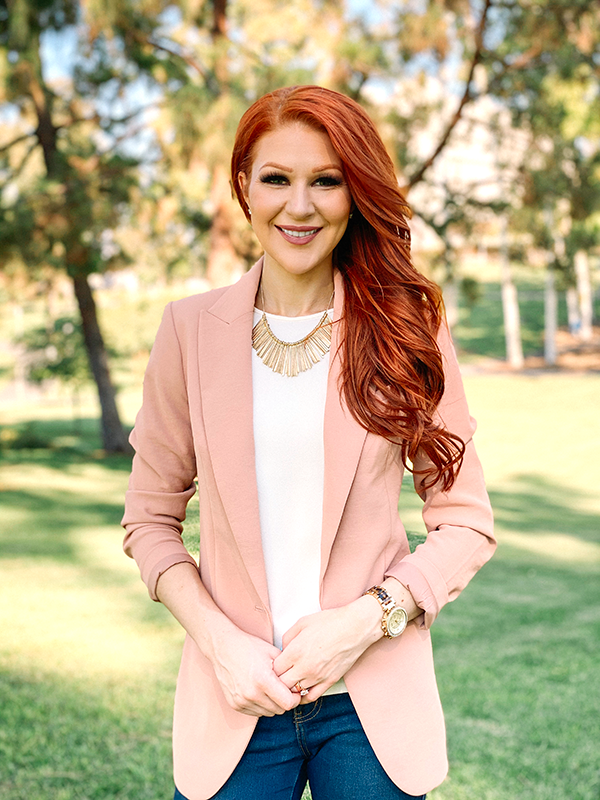Cheerleading for Science: Q&A with Postdoctoral Scholar Wendy Brown

Jan. 13, 2022 – Cheerleading or science, pom poms or microscopes? Does one have to choose? Not according to Wendy Brown, UC Irvine postdoctoral scholar in biomedical engineering and former NFL cheerleader. Both are shared loves for Brown, and she uses her own experience to inspire young girls to follow her path into STEM.
Brown, a L'Oréal 2020 For Women in Science Fellow, works with Kyriacos Athanasiou, Distinguished Professor of biomedical engineering. Athanasiou’s interdisciplinary research group focuses on understanding the healing processes of cartilage and augmenting those processes via sound application of tissue engineering principles. Brown is researching the engineering of cartilage for facial reconstruction.
But for the past 10 years, she has taken the time to encourage girls and young women to pursue STEM studies and careers as a member of Science Cheerleaders. She currently serves as director of outreach and was recently interviewed by FloCheer.
Here, she shares her story of why she’s a cheerleader for STEM.
How would you describe the Science Cheerleaders program?
The Science Cheerleaders are a national nonprofit organization of over 300 current and former professional and collegiate cheerleaders with degrees and careers in STEM. We lead science-themed cheers and hands-on STEM learning opportunities to playfully challenge stereotypes and leverage girls' interests in activities they already like doing (cheerleading and dancing) to defuse the intimidation of science. Our goals are to inspire, engage and empower girls to pursue their dreams in STEM, and show them that the skills they have developed as cheerleaders and dancers will help make them great as STEM professionals.
How long have you been involved?
I've been involved with the Science Cheerleaders since 2011. As soon as I learned about the organization, I knew I wanted to join. Growing up, I really struggled to reconcile my interests in dancing and science. I was well into college at Georgia Tech before I fully realized that I could be successful at both.
For me, the turning point was working with a mentor I could relate to. She was a physician running her own practice and had been the feature twirler at Georgia Tech, while earning her undergraduate degree in chemical engineering. She also was crowned Miss Georgia while she was in medical school. She believed in me and served as an example of what was achievable.
From then on, I was more confident in unapologetically pursuing my goals in both science and dancing/cheerleading and no longer saw them as mutually exclusive. At the time, I was on Georgia Tech’s Goldrush Dance team and served as the captain in my last year. I went on to cheer professionally for a total of seven years for the Atlanta Falcons, Sacramento Kings and Oakland (now Las Vegas) Raiders, and I served as line captain for the Raiders, all while finishing my undergraduate degree and doctorate in biomedical engineering. Because of my experiences, the mission of the Science Cheerleaders is very near and dear to my heart.
What is your role?
In addition to being one of the Science Cheerleaders, I serve as the director of outreach. I help develop new STEM materials and activities that the Science Cheerleaders use at our events. I work with the other directors and our founder, Darlene Cavalier, to form new partnerships and plan events, such as our most recent one at the Pop Warner National Cheer and Dance Championships. As a Science Cheerleader, I attend these events to meet girls, talk to them about our love of science, lead them through hands-on STEM activities, and perform science-themed dances and cheers.
What is one of the best things you’ve seen as part of the program?
I love seeing what I call a "lightbulb moment," when it's obvious that someone's thinking has been recalibrated. When we talk to young girls, it's common for them to initially be shy or embarrassed to admit that they like science. So, it's extremely rewarding to see them open up and become more confident about their interests after talking and working with them. I've even heard girls excitedly say, "I can't wait for science class!" as they walk away from our meeting.
Another really important transition I love to see is in the attitude of parents. Frequently parents feel that for their girls to be successful or taken seriously in science and math, they need to give up their "girly" hobbies, like cheerleading, to completely focus on school. We try to show the parents that you can indeed pursue both and that our careers in cheer and dance have actually contributed to successes in our science careers.
What do you hope to achieve?
Overall, I would love to see more women in professional STEM careers and to know that the obstacles they face along the way are becoming lower and fewer. I hope that I can contribute to that by making science "cool" and by inspiring girls to stay interested in science at the pivotal age when they frequently lose interest (usually 6-8th grade). I hope that these young women can learn from my journey and the experiences of the other Science Cheerleaders to have the confidence to pursue their dreams without having to go through the same hardships that we did.
"Engineering's got the beat to make you stomp your feet!" exclaim Kirk Park Pop Warner cheerleaders at the Pop Warner National Cheer and Dance Championships in December 2021. Video by Wendy Brown for Science Cheerleaders.
– Tonya Becerra
